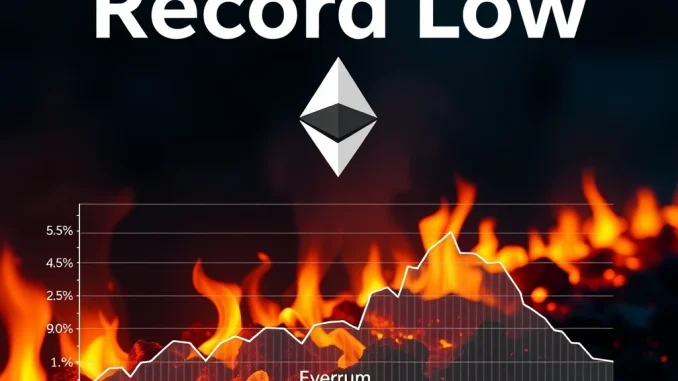
Hold onto your hats, crypto enthusiasts! The Ethereum network, a powerhouse in the blockchain world, has just witnessed something quite remarkable – and perhaps a little concerning. According to the latest data from DeFiLlama, Ethereum’s monthly burn value has plummeted to an all-time low in March, hitting a mere $7.55 million. Yes, you read that right – a record low!
What’s Fueling the Plunge in Ethereum Burn Rate?
For those new to the crypto lingo, let’s quickly break down what ‘burn’ means in the Ethereum context. Think of it like this: every time a transaction happens on the Ethereum network, a small fee, known as the ‘base fee’, is ‘burned’ – essentially removed from circulation forever. This mechanism, introduced with the EIP-1559 upgrade in August 2021, was designed to make ETH a deflationary asset and stabilize transaction fees. But lately, the flames of this burn mechanism seem to be dimming. So, what’s behind this dramatic decrease in the Ethereum burn rate?
- Reduced Network Activity: The most straightforward explanation is simply less activity on the Ethereum network. Fewer transactions mean fewer fees burned. This could be due to various factors, including market conditions, decreased interest in certain DeFi applications, or users migrating to other Layer-2 solutions.
- Lower Gas Prices: Gas prices, the cost of transactions on Ethereum, have been relatively lower recently. Lower gas prices naturally lead to a smaller base fee and, consequently, a reduced ETH burn. This is generally seen as a positive for users as it makes transactions cheaper, but it directly impacts the burn rate.
- Seasonal Trends?: It’s possible that there are seasonal patterns at play. Crypto markets are known for their volatility and cyclical nature. Perhaps March traditionally sees a dip in on-chain activity, though more data over time would be needed to confirm this.

DeFiLlama Data Paints a Stark Picture of Diminished Burn Value
The numbers from DeFiLlama data are quite telling. To put the $7.55 million monthly burn value into perspective, consider that daily ETH burns on March 30th even dipped below a paltry $100,000! This placed Ethereum a surprising 22nd in burn activity among all blockchains. Just think about that – a network as massive as Ethereum ranking so low in burn activity is definitely noteworthy. It underscores the significant decrease we’re witnessing in the Ethereum burn rate.
Here’s a quick table to highlight the key data points:
| Metric | Value |
|---|---|
| Monthly Ethereum Burn Value (March) | $7.55 Million (Record Low) |
| Daily ETH Burn (March 30th) | Below $100,000 |
| Ethereum Burn Activity Rank | 22nd Among Blockchains |
| Current ETH Price (as of writing) | $1,825.71 |
Is a Lower Ethereum Burn Rate a Cause for Concern or Celebration?
Now, for the million-dollar question: is this low burn value something to be worried about, or is it actually a good thing? The answer, as is often the case in crypto, is nuanced and depends on your perspective.
Potential Concerns:
- Reduced Deflationary Pressure: The primary goal of the burn mechanism was to make ETH a deflationary asset over time, potentially increasing its scarcity and value. A lower burn rate means less ETH is being removed from circulation, reducing this deflationary pressure. This could, in theory, dampen potential price appreciation driven by scarcity.
- Indicator of Network Health?: Some might interpret a drastically reduced burn rate as a sign of declining network health or user interest. While this might be partially true (less activity), it’s crucial to consider the broader context and other factors influencing network usage.
Potential Positives:
- Lower Transaction Fees: As mentioned earlier, lower gas prices are a direct contributor to the lower burn rate. For everyday users and developers, cheaper transactions are undoubtedly a welcome development, making the Ethereum network more accessible and user-friendly.
- More Stable Gas Prices?: A consistently lower burn rate, if it persists, might contribute to more stable and predictable gas prices in the long run. Volatility in gas fees has been a persistent pain point for Ethereum users, and greater stability could enhance the user experience.
- Shifting Focus to Layer-2 Solutions: The reduced activity on the main Ethereum chain might also indicate the growing success of Layer-2 scaling solutions. Users and applications are increasingly migrating to Layer-2s like Arbitrum, Optimism, and zk-Rollups for faster and cheaper transactions. While transactions on Layer-2s don’t directly contribute to the main Ethereum chain’s burn rate, they still benefit the Ethereum ecosystem as a whole.
Ethereum Price Holds Steady Amidst Burn Rate Decline
Interestingly, despite the record low Ethereum burn rate, the price of ETH has remained relatively stable. Currently trading around $1,825.71, ETH is even up slightly (0.92% in the last 24 hours, according to CoinMarketCap at the time of writing). This suggests that the market isn’t immediately reacting negatively to the reduced burn rate. It could be that the market is already pricing in the shift towards Layer-2 solutions or that other factors are currently outweighing the burn rate in determining ETH’s price action.
It’s important to remember that the crypto market is incredibly dynamic and influenced by a multitude of factors. While the Ethereum burn rate is an important metric to watch, it’s just one piece of the puzzle.
Looking Ahead: What Does the Future Hold for Ethereum’s Burn Mechanism?
The dramatic dip in Ethereum’s monthly burn value certainly raises some interesting questions about the future of the burn mechanism and its impact on ETH. Will the burn rate rebound as network activity picks up again? Or is this a sign of a more permanent shift in Ethereum’s on-chain dynamics? Only time will tell.
For now, it’s crucial to keep a close eye on the Ethereum burn rate, alongside other key metrics like network activity, gas prices, and the growth of Layer-2 solutions. Understanding these trends will be essential for navigating the ever-evolving landscape of the Ethereum ecosystem and making informed decisions in the crypto space.
Actionable Insights:
- Monitor DeFiLlama Data: Regularly check DeFiLlama and similar data sources to track the Ethereum burn rate and compare it to historical trends.
- Track Network Activity: Keep an eye on metrics like transaction count and active addresses on the Ethereum network to gauge overall activity levels.
- Consider Layer-2 Impact: Factor in the growing influence of Layer-2 solutions and their potential impact on main chain activity and burn rates.
- Stay Informed: Keep up-to-date with Ethereum network upgrades and developments that could influence gas prices and the burn mechanism.
In conclusion, the record low Ethereum burn rate in March is a significant event that warrants attention. While it might raise some eyebrows regarding deflationary pressure, it also reflects potentially positive developments like lower transaction fees and the rise of Layer-2 solutions. As the Ethereum ecosystem continues to evolve, understanding the nuances of the burn mechanism and its influencing factors will be crucial for anyone involved in the world of crypto.



